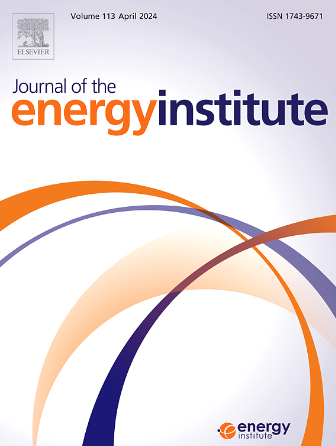Oxygen updraft gasification of euro cotton banknotes waste for hydrogen-rich syngas production
IF 6.2
2区 工程技术
Q2 ENERGY & FUELS
引用次数: 0
Abstract
Euro cotton banknote waste (BW) is one of the challenges that the EU region has recently sought vigorously to integrate into the circular economy and to encourage research and investment in its valorisation in order to preserve this sector and reduce its environmental risks. Within this framework, this research aims to study the possibility of treating BW using gasification process and converting it into hydrogen (H2)-rich syngas. Gasification experiments were performed on euro banknote-based cotton waste that underwent pre-pelletizing treatment to produce uniform BW granules. The conversion process was carried out using a continuous updraft gasifier system with a capacity up to 1 kg/h in oxygen agent. To optimize the process and obtain ideal conditions that can release the maximum amount of H2 into the synthesized gas, the experiments were conducted at different temperatures (700, 800, 900 °C) and air-fuel equivalence ratios (ER: 0.19, 0.24, 0.29). The syngas, tar, and soot gasification products were characterized using Gas chromatography, Scanning electron microscope (SEM), and Fourier-transform infrared spectroscopy (FTIR). The results show that at 700 °C (ER = 0.24), the maximum syngas production rate (1.16 kg/h) with HHV 9.1 MJ/kg can be obtained together with production of 0.05 kg/h (tar) and 0.79 kg/h (soot). Meanwhile, the highest H2 content (up to 19 %) was obtained at 900 °C (ER = 0.19) with less tar (0.01 kg/h) and soot (0.49 kg/h). Accordingly, BW treatment using the gasification process is a promising technology for its disposal, especially at a high temperature (900 °C) to convert it into H2-rich syngas with smaller quantity of tar and soot components.
利用氧气上升气流气化欧元棉钞废料以生产富氢合成气
欧元棉钞废料(BW)是欧盟地区最近大力寻求将其纳入循环经济的挑战之一,并鼓励对其价值化进行研究和投资,以保护这一行业并降低其环境风险。在此框架下,本研究旨在研究使用气化工艺处理生物武器并将其转化为富含氢气(H2)的合成气的可能性。气化实验的对象是经过预造粒处理的欧元棉花废料,以生产出均匀的棉花废料颗粒。转化过程是使用连续上升气流气化炉系统进行的,该系统在氧气剂中的处理能力可达 1 公斤/小时。为了优化工艺并获得可在合成气中释放最大 H2 量的理想条件,实验在不同温度(700、800、900 °C)和空气-燃料当量比(ER:0.19、0.24、0.29)下进行。使用气相色谱法、扫描电子显微镜(SEM)和傅立叶变换红外光谱(FTIR)对合成气、焦油和烟尘气化产物进行了表征。结果表明,在 700 °C 条件下(ER = 0.24),合成气产量最高(1.16 kg/h),HHV 为 9.1 MJ/kg,焦油产量为 0.05 kg/h,烟尘产量为 0.79 kg/h。同时,在 900 °C 条件下(ER = 0.19),H2 含量最高(达 19%),焦油(0.01 千克/小时)和烟尘(0.49 千克/小时)产生量较少。因此,使用气化工艺处理生物武器是一种很有前景的处理技术,尤其是在高温(900 °C)条件下,可将其转化为富含 H2 的合成气,焦油和烟尘成分的数量也较少。
本文章由计算机程序翻译,如有差异,请以英文原文为准。
求助全文
约1分钟内获得全文
求助全文
来源期刊

Journal of The Energy Institute
工程技术-能源与燃料
CiteScore
10.60
自引率
5.30%
发文量
166
审稿时长
16 days
期刊介绍:
The Journal of the Energy Institute provides peer reviewed coverage of original high quality research on energy, engineering and technology.The coverage is broad and the main areas of interest include:
Combustion engineering and associated technologies; process heating; power generation; engines and propulsion; emissions and environmental pollution control; clean coal technologies; carbon abatement technologies
Emissions and environmental pollution control; safety and hazards;
Clean coal technologies; carbon abatement technologies, including carbon capture and storage, CCS;
Petroleum engineering and fuel quality, including storage and transport
Alternative energy sources; biomass utilisation and biomass conversion technologies; energy from waste, incineration and recycling
Energy conversion, energy recovery and energy efficiency; space heating, fuel cells, heat pumps and cooling systems
Energy storage
The journal''s coverage reflects changes in energy technology that result from the transition to more efficient energy production and end use together with reduced carbon emission.
 求助内容:
求助内容: 应助结果提醒方式:
应助结果提醒方式:


